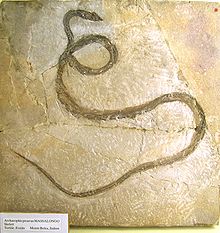Archaeophis
Appearance
| Archaeophis Temporal range: Eocene
| |
|---|---|

| |
| Scientific classification | |
| Domain: | Eukaryota |
| Kingdom: | Animalia |
| Phylum: | Chordata |
| Class: | Reptilia |
| Order: | Squamata |
| Suborder: | Serpentes |
| Family: | †Palaeophiidae |
| Genus: | †Archaeophis Massalongo, 1859 |
| Species: | †A. proavus
|
| Binomial name | |
| †Archaeophis proavus Massalongo, 1859
| |
Archaeophis proavus is an extinct species of marine palaeophiid snake from the Eocene of Monte Bolca, Italy. It had the highest vertebral count known among snakes, with 565 vertebrae.[1]
Massalongo [2] also described a second species in the genus, A. bolcensis, but this was subsequently placed in the new genus Anomalophis.[3] Another species, A. turkmenicus from Turkmenistan, is also thought to most likely belong to a distinct, currently undescribed genus.[4]
References
[edit]- ^ Smith, K. T.; Georgalis, G. L. (2022). "The diversity and distribution of Palaeogene snakes: a review, with comments on vertebral sufficiency". In Gower, D.; Zaher, H. (eds.). The Origin and Early Evolution of Snakes. Cambridge University Press. pp. 55‑84. ISBN 9781108938891.
- ^ Massalongo, A. (1859). Specimen photographicum animalium quorumdam plantarumque fossilium Agri Veronensis. Vicentini-Franchini. p. 101.
- ^ Auffenberg, W. (1959). "Anomalophis bolcensis (Massalongo), a new genus of fossil snake from the Italian Eocene". Breviora. 114: 1–16.
- ^ Rage, Jean-Claude; Bajpai, Sunil; Thewissen, Johannes G. M.; Tiwari, Brahma N. (2003). "Early Eocene snakes from Kutch, Western India, with a review of the Palaeophiidae". Geodiversitas. 25 (4): 695–716 – via ResearchGate.
